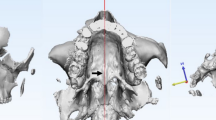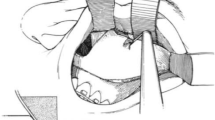Abstract
Purpose
In Le Fort 1 osteotomy when a maxillary impaction is necessary, surgeons have to face different anatomical problems. (1) To determine the best bone resection route, they have to consider the situation of dental roots, infraorbital foramen and maxillary artery. (2) In case of Le Fort 1 osteotomy combined with a mandibular sagittal split osteotomy, the palate has to be replaced in horizontal position although there is no anatomical landmark. (3) In case of Gummy smiles, it can be due to either long face or short upper lip. The main objective was to identify safe bony landmarks to perform a Le Fort I osteotomy and to find a reliable way for repositioning the palate horizontally; the secondary objective was to determine the upper lip normal length.
Methods
The study was based on 178 facial CT examinations. The following parameters have been used: the vertical length of the upper lip, the vertical heights of the anterior nasal spine, the canine and molar roots, the inferior limit of the pterygomaxillary fossa and the vertical height of the infraorbital foramen on both sides.
Results
The vertical length from the subnasal point to the upper vermilion was 15.06 ± 3.09 mm, and to the junction of the upper and lower lips was 23.94 ± 3.79 mm. The vertical length from the anterior nasal spine to the incisor alveolar border was 19.70 ± 3.17 mm. The height of the canine root was 17.11 ± 2.60 mm. The height of the highest lateral root of first or second maxillary molars was 11.71 ± 1.83 mm. The vertical length from the inferior limit of the pterygomaxillary fossa (pti point) to the alveolar border of the pterygomaxillary suture was 19.86 ± 3.45 mm. The height from the center of the infraorbital foramen to the alveolar border of the maxilla on a vertical line was not statistically different on right and left sides.
Conclusions
According to our results, in impaction Le Fort 1 osteotomy, the bone resection must pass 20 mm above the alveolar border in canine area, and 15 mm above the alveolar border in molar area. The resection has to end less than 20 mm above the inferior border of the pterygomaxillary suture. The vertical height of the infraorbital foramen is a consistent landmark for repositioning of the palate in a horizontal plane.






Similar content being viewed by others
References
Angelillo JC, Dolan EA (1982) The surgical correction of vertical maxillary excess (long face syndrome). Ann Plast Surg 8:64–70
Ariji Y, Obayashi N, Goto M, Izumi M, Naitoh M, Kurita K, Shimozato K, Ariji E (2006) Roots of the maxillary first and second molars in horizontal relation to alveolar cortical plates and maxillary sinus: computed tomography accessment for infection spread. Clin Oral Investig 10:35–41
Bell WH (1973) Biologic basis for maxillary osteotomies. Am J Phys Anthropol 38:279–289
Bell WH (1975) LefortI osteotomy for correction of maxillary deformities. J Oral Surg 33:412–426
Bell WH, Creekmore TD, Alexander RG (1977) Surgical correction of the long face syndrome. Am J Orthod 71:40–67
Bendrihem R, Vacher C (2016) Radiologic anatomy of the maxillary artery in the pterygopalatine area applied to Le Fort 1 osteotomies. Surg Radiol Anat 39:23–27
Bobek S, Farrell B, Choi C, Farrell B, Weimer K, Tucker M (2015) Virtual surgical planning for orthognathic surgery using digital data transfer and an intraoral fiducial marker: the charlotte method. J Oral Maxillofacial Surg 73:1143–1158
Daenecke S, Bianchini EM, da Silva AP (2006) Anthropometrical measurements of the height of the upper lip and length of the philtrum. Pro Fono 18:249–258
Dayakar MM, Gupta S, Shivananda H (2014) Lip repositioning: an alternative cosmetic treatment for gummy smile. J Indian Soc Periodontol 18:520–523
De Jongh M, Barnard D, Birnie D (1986) Sensory nerve morbidity following Le Fort 1 osteotomy. J Maxillofac Surg 14:10–13
Ellingsen RH, Artun J (1993) Pulpal response to orthognathic surgery: a long-term radiographic study. Am J Orthod Dentofac Orthop 103:338
Farkas LG, Katic MJ, Hreczko TA, Deutsch C, Munro IR (1984) Anthropometric proportions in the upper lip—lower lip—chin area of the lower face in young white adults. Am J Orthod 86:52–60
Flores-Mir C, Witt MM, Heo G, Major PW (2014) Analysis of anterior dentoalveolar and perioral aesthetic characteristics and their impact on the decision to undergo a Phase II orthodontic treatment. Eur J Orthod 36:719–726
Gui H, Zhang S, Luan N, Lin Y, Shen SG, Bautista JS (2015) A novel system for navigation-and robot-assisted craniofacial surgery: establishment of the principle prototype. J Craniofac Surg 26:e746–e749
Harada K, Sato M, Omura K (2004) Blood-flow and neurosensory changes in the maxillary dental pulp after differing Le Fort 1 osteotomies. Oral Surg Oral Med Oral Pathol Oral Radiol Endod 97:12–17
Ishida LH, Ishida LC, Ishida J, Grynglas J, Alonso N, Frerreira MC (2010) Myotomy of the levator labii superioris muscle and lip repositioning: a combined approach for the correction of gummy smile. Plast Reconstr Surg 126:1014–1019
Jahanbin A, Pezeshkirad H (2008) The effects of upper lip height on smile esthetic perception in normal occlusion and nonextraction, othodontically treated females. Indian J Dent Res 19:204–207
Justus T, Chang BL, Bloomquist D, Ramsay DS (2001) Human gingival and pulpal blood flow during healing after Le Fort 1 osteotomy. J Oral Maxillofac Surg 59:2
Miron H, Calderon S, Allon D (2012) Upper lip changes and gingival exposure on smiling: vertical dimension analysis. Am J Orthod Dentofacial Orthop 141:87–93
Miskinyar SA (1983) A new method for correcting a gummy smile. Plast Reconstr Surg 72:397–400
Murphy RJ, Gordon CR, Basafa E, Liacouras P, Grant GT, Armand M (2015) Computer-assisted, Le Fort-based, face-jaw-teeth transplantation: a pilot study on system feasibility and translational assessment. Int J Comput Assist Radiol Surg 10:1117–1126
Ohba S, Kohara H, Kawasaki T, Fujimura Y, Yoshida N, Asahina I (2013) A patient with severe maxillary gingival exposure treated with combined compression osteogenesis of the anterior alveolar bone and conventional Le Fort I osteotomy. J Craniofac Surg 24:2068–2072
Ok E, Güngör E, Colak M, Altunsoy M, Nur BG, Aglarci OS (2014) Evaluation of the relationship between the maxillary posterior teeth and the sinus floor using cone-beam computed tomography. Surg Radiol Anat 36:907–914
Raschke GF, Rieger UM, Peisker A, Djedovic G, Gomez-Dammeier M, Guentsch A, Schaefer O, Schultze-Mosgau S (2015) Morphologic outcome of bimaxillary surgery: an anthropometric appraisal. Med Oral Patol Oral Cir Bucal 20:103–110
Rosenberg A, Sailer HF (1994) A prospective study on changes in the sensibility of the oral mucosa and the mucosa of the upper lip after Le Fort 1 osteotomy. J Craniomaxillofac Surg 22:286
Shimo T, Nishiyama A, Jinno T, Sasaki A (2013) Severe gummy smile with class II malocclusion treated with LeFortI osteotomy combined with horseshoe osteotomy and intraoral vertical ramus osteotomy. Acta Med Okayama 67:55–60
Sung-Hoon H, Eon-Hwa L, Jin-Hyoung C, Jong-Moon C, Sang-Cheol K, Na-Young C, Kyung-Hwa K (2013) Evaluation of the relationship between upper incisor exposure and cephalometric variables in Korean young adults. Korean J Orthod 43:225–234
Thygesen TH, Bardow A, Norholt SE, Jensen J, Svensson P (2009) Surgical risk factors and maxillary nerve function after Le Fort 1 osteotomy. J Oral Maxillofac Surg 67:528–536
Author information
Authors and Affiliations
Corresponding author
Ethics declarations
Conflict of interest
The authors declare that they have no conflict of interest.
Rights and permissions
About this article
Cite this article
Bendrihem, R., Vacher, C., Fohlen, A. et al. Anatomic basis of Le Fort 1 impaction osteotomy: a radiological study. Surg Radiol Anat 39, 1209–1214 (2017). https://doi.org/10.1007/s00276-017-1870-7
Received:
Accepted:
Published:
Issue Date:
DOI: https://doi.org/10.1007/s00276-017-1870-7




